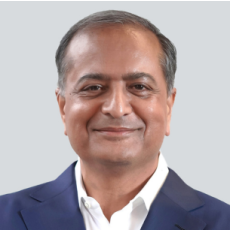SiTime is a leader in semiconductor based precision timing solutions, having shipped billions of units.
Could you share some of the key experiences that shaped you and what led you to SiTime?
I have been involved in various startups, but this is only my second time as a CEO. I began as a product manager in the late 1980s, then moved into a software startup in the late '90s. My first CEO role came in 1999 with Ikanos Communications, where I joined as a co-founder. We started with very modest beginnings—two guys in an empty office without even a lock on the door. It was a hands-on learning experience that shaped my approach to leadership and business-building.
Ikanos went public in 2005, and while we achieved 95% market share in DSL technology, I learned that even success in a niche market has limits if the market size itself doesn’t grow. We reached $120 million in sales and a $600 million market cap, but I wanted a bigger opportunity. That is what drew me to SiTime: the chance to disrupt a $5 billion precision timing market dominated by 70-year-old quartz crystal technology. Today, that market has doubled to $10 billion, with potential for further growth.
SiTime operates in a very specialized space—precision timing technology. For readers unfamiliar with the field, can you explain what SiTime does, the complexities involved, and the unique value it brings to its customers?
Precision timing is about accurately delivering time, which has been crucial since the days of oceanic exploration. Back then, ships often ended up far from their intended destinations due to inaccurate timing. Today, precision timing is vital for applications like automated driving, where cars need to communicate in real-time to ensure safety. It is also critical in AI, enabling fast data processing and low latency for high-performance computing. Our technology addresses challenges where precision timing is crucial, such as GPS systems and defense. For instance, it helps prevent issues like GPS "spoofing," where signals are manipulated to show incorrect locations. This is essential for systems that rely on accurate positioning and timing, whether it's a car, a smartphone, or military equipment.
The rise of IoT and 5G seems to be a major focus for SiTime. Why do you see these technologies as crucial for your business, and are there any other emerging areas that you believe will drive growth for SiTime?
5G and IoT are key because they demand high-speed, high-performance, and high-accuracy solutions, often in challenging environments like those with extreme temperature changes or vibrations. Our precision timing ensures that devices perform reliably in these conditions, providing consistency where it’s most needed. Beyond IoT and 5G, we see significant potential in automated driving and AI, where precise timing is essential for coordination and processing. As the industry evolves, we are positioned to meet the needs of emerging technologies that require robust timing solutions.
How do you see the future for SiTime and the role of precision timing in upcoming technologies?
The future is promising as precision timing becomes more critical across industries. Imagine a phone that doesn’t rely on GPS but carries its own atomic clock—while such technology is expensive today, we foresee a time when SiTime could make it more accessible. This would enable devices to operate independently of external signals, offering new levels of reliability. We also see opportunities in rugged wearables, like high-end smartwatches used in extreme conditions, and the growing demand for timing solutions in robotics and automated vehicles. As these technologies become more mainstream, the need for precision timing will continue to expand, and SiTime is well-prepared to support that growth.
What makes SiTime attractive to talented engineers, especially with the lure of larger tech companies in Silicon Valley?
We create an environment where people can make a significant impact. Despite being a 400-person company, I interview all new hires to ensure they are ready to lead and innovate. We look for those who want more than just a job—they want to contribute to solving important challenges. Alongside competitive pay, we offer the opportunity to work on meaningful projects. People want to feel their work matters, and at SiTime, they can take pride in helping shape the company’s trajectory. It’s this sense of purpose and opportunity for growth that sets us apart from larger tech giants, offering a unique space for innovation and impact.
What keeps you up at night as you look to grow SiTime in the coming years?
With 25 years of experience as a CEO, I've faced many challenges, but I focus on progress. The key is building a resilient company culture that adapts to new challenges.
We aim to foster a culture of openness, risk-taking, and collaboration, where everyone is aligned towards our shared goals. I believe that a strong, motivated team is what drives SiTime's success. My focus is on creating an environment where people can thrive and feel they are making a real impact. This sense of purpose allows me to rest easy, knowing that our team is equipped to handle whatever comes next.
What key milestones or advancements excite you about SiTime's future?
One goal is to develop a significantly smaller, more affordable atomic clock with improved resilience. This would open up new possibilities across various sectors. Another milestone would be to introduce our MEMS resonator technology as a standalone product, further challenging the traditional quartz crystal market. On the business front, we of course seek to grow our revenue and market share in a way that delivers value to our investors. Beyond financial goals, we aim to make a positive impact in the regions where we operate, including expanding in countries like India and Malaysia. It’s about being a responsible, impactful global player while driving technological innovation.
Do you believe SiTime has achieved its goal of market disruption in the timing industry?
I believe we have. Disrupting a market like precision timing takes time, but the impact is becoming more evident. Our approach has been to challenge the status quo, offering semiconductor-based solutions in a market traditionally dominated by quartz technology. As more industries recognize the advantages of our solutions, I believe our influence will become even clearer.






